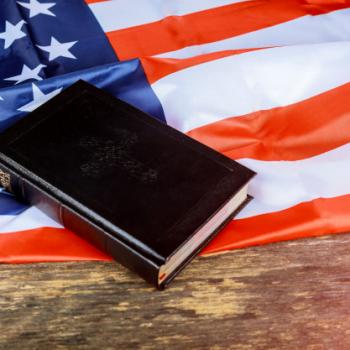For a number of years now, I have been privileged to attend the White House Chanukah party in the presence the President. Each year, I am so deeply inspired that I live in a country that strongly supports religious commitment while protecting the rights of religious minorities from any possible religious coercion. History has shown repeatedly that nations with an established religion often abuse that combined power by oppressing those with minority views. We must be constantly vigilant to ensure this necessary and proper separation.
Religion and State
We all wish to live in a moral society, but how do we balance our spiritual and political systems? Judaism was not meant to be a relic of the ghetto: Torah was intended to permeate the hearts and souls of its students and to impact society. The Jewish religion, however, was not intended to place a coercive imposition on society. From a perspective of self-interest, minority groups want to be protected and insulated from the impositions of majority religious practice. However, from a collective interest, not minority interest, it is fair for democracies to reflect majority values (whether they are of religious or secular origin) and have those values integrated into society.
The 14th century Ran, Rabbeinu Nissim, in his famous 11th homily, endorsed a separation between religion and state. Ran suggested that the Torah embraces two different levels of justice. First, the beit din (Jewish court) is to uphold the Torah’s laws. The “king,” on the other hand (secular leadership), is to maintain a higher-level order, and in many ways operates outside of Jewish law. The balance between religious duty and normative secular practice is thus kept in a state of balance.
The religion and state relationship in America grew out of the situation in Europe (and specifically the religious politics of Stuart England) at the time the English colonies were founded. On the continent, the wars of the Reformation only ended with the conclusion of the Thirty Years’ War in 1648. In England, after securing permanent Protestant rule, the Puritans waged a civil war against King Charles I and his monarchist followers. The Puritans won, Cromwell became protector of the realm and, in 1649, Charles I was beheaded. They sought unsuccessfully to abolish the monarchy and only rule through Parliament, but in 1660 the monarchy was restored under Charles II.
At this time, most American colonies were sectarian, either supporting the Puritan (Congregational) or Church of England as their established churches, supported by colonial funding. The Congregational Church opposed the religious (and political) authority of the King, preferring to have each “congregation” rule itself. In the South, the Church of England was the established church. In the Church of England, from the time of is inception under Henry VIII to the present, the monarch is considered the “Supreme Governor of the Church of England,” and appoints many of the leaders of the clergy (some of whom sit in the House of Lords). Each colony had some form of intolerance towards most other sects, especially Catholics; Massachusetts went so far as to hang a number of Quaker missionaries.
However, most of the middle Atlantic colonies (as well as Rhode Island) did not have an established church. Pennsylvania was founded by William Penn, a Quaker and a firm believer in religious toleration and the notion that one promoted religious values through moral example. Pennsylvania was a haven for persecuted Protestant sects as well as for a small population of Jews, indeed even Catholics. New York, a former Dutch colony, had from its beginnings a diverse population (this despite Peter Stuyvesant’s attempts to banish Jews from the city). For example, a 1771 map of New York City showed religious houses of worship for 11 different sects, including a synagogue. Diversity was directing America away from having an established church.
Read the rest here











